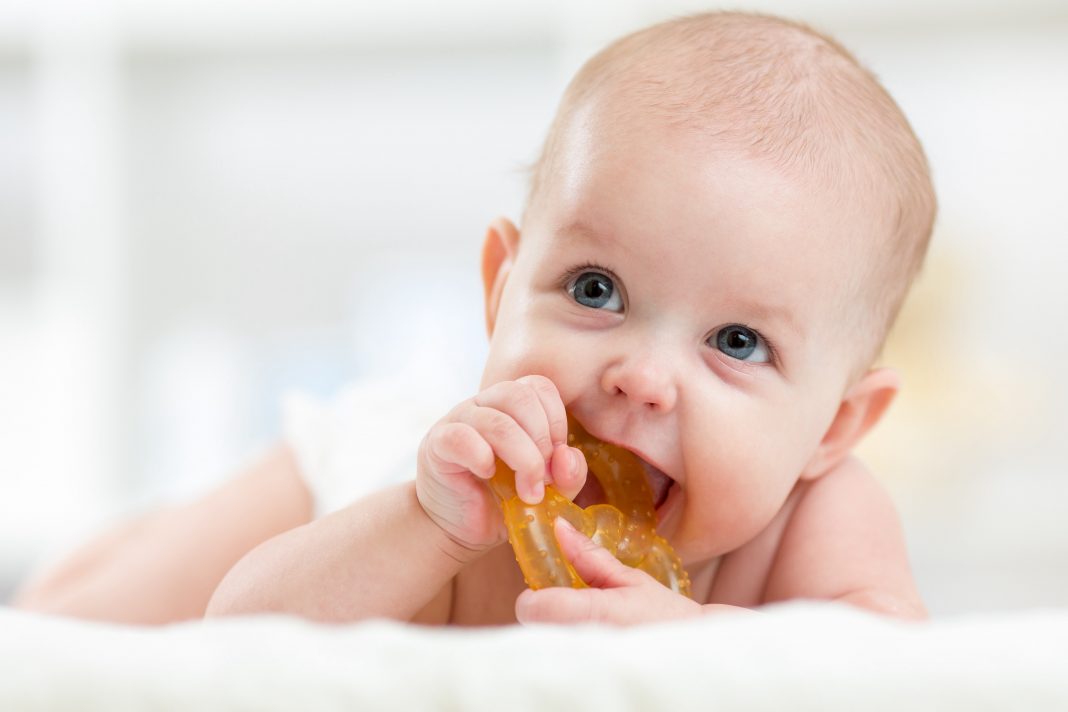Many memorable moments and milestones occur in a child’s first couple of years, but along with these will come the not-so-beautiful experiences, such as teething.
In the October issue of Retail Pharmacy Assistants, we present some of the tips pharmacy assistants should be aware of to pass on to their community and customers regarding the management of teething issues.
Baby teeth often start to appear around nine months of age but timing can range from three to 12 months, so it’s important for pharmacy assistants to ask what age a guardian’s little one is if they present in a pharmacy looking for management tips. Teething can be uncomfortable for some babies, who may appear more upset and bad-tempered than others.1
Quick timeline on teeth care
- From birth: Clean mouth and gums with a soft cloth.
- First tooth: Brush twice a day with a soft toothbrush and plain water.
- 12 months: Take the child to their first dental appointment.
- 18 months: Use a pea-sized amount of low-fluoride children’s toothpaste and encourage the child to spit out the toothpaste instead of swallowing.
- Two and a half years: Begin flossing between any teeth that touch.
- Four to five years: Start teaching the child to brush their own teeth.
- Six years: Make the switch to adult toothpaste, and teach children to floss their own teeth.
- Eight years: Allow the child to brush and floss unsupervised and continue with regular dental check-ups.2
Spotting discomfort
It’s important for pharmacy assistants to be able to detect signs of discomfort or pain, and indicators of teething, to help parents and guardians presenting with their kids.
Signs and symptoms include:1
- Red, swollen gums.
- Flushed cheeks.
- Dribbling.
- Showing irritability and restlessness.
- A slight fever.
- Pulling the ear on the same side as the erupting tooth.
- Sucking fingers and fists.
Easing discomfort
When a child is teething, all a parent or guardian wants to do is help their child and ease their pain. Pharmacy assistants can provide as many tips as possible for them, and if nothing seems to work, they should contact their dentist or GP.
Such tips include:1
- Gently rub the baby’s gums to soothe pain – washing hands first!
- Give the baby a cool (but not frozen) teething ring or dummy.
- Gently run a cool clean facecloth on the back of a cold spoon along the child’s gums.
- Give the baby something firm to suck on, such as a sugar-free rusk.
To be aware of or avoid
Parents or guardians should double-check with a doctor or dentist before using these products:1
Teething gels. Cold teething gels can provide short-term relief for children but it’s difficult for parents and guardians to monitor how much gel is swallowed. Swallowing a certain amount of gel can make the throat numb and cause a choking hazard.
Amber beads. Beaded necklaces or bracelets are a potential choking hazard with experts suggesting they rarely provide pain relief for teething children.1
Products from a pharmacy
Some of the products available in pharmacies to help manage teething pain include:
- Brauer’s Baby and Child Teeth Gel.
- Corams Gripe Water.
- Bonjela Teething & Mouth Ulcer Gel.
- Infants’ Friend Oral Liquid.
- Bubs & Co Teething Gel.
- Malarkey Kids Munch-It Blanket Cacti Cutie.
- Malarkey Kids Munch Mitt Teething Mint Green.
References:
- Department of Health and Aged Care. ‘Teething’. pregnancybirthbaby.org.au/teething
- Better Health Channel. ‘Teeth development in children’. betterhealth.vic.gov.au/health/conditionsandtreatments/teeth-development-in-children
This feature was originally published in the October issue of RPA e-magazine.







